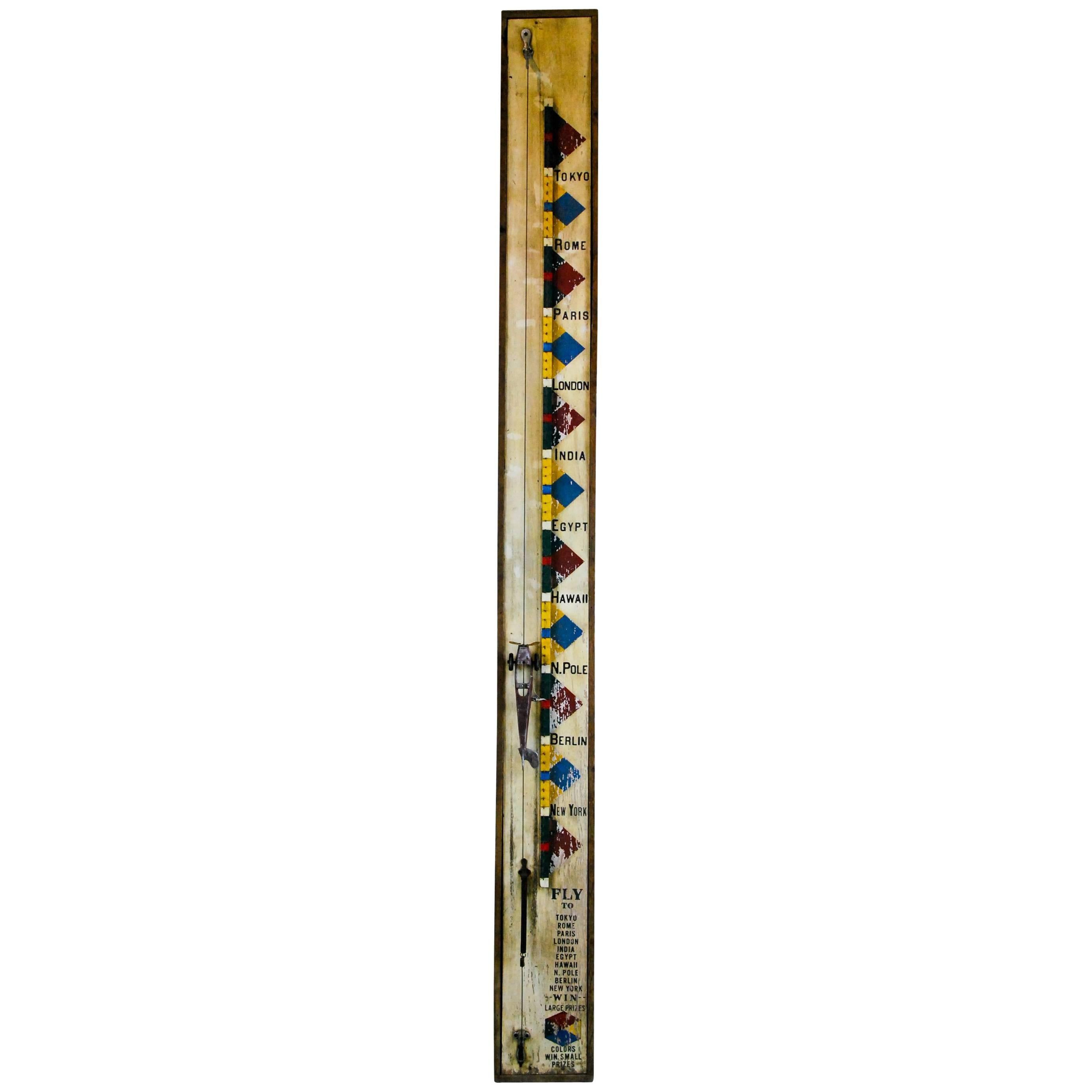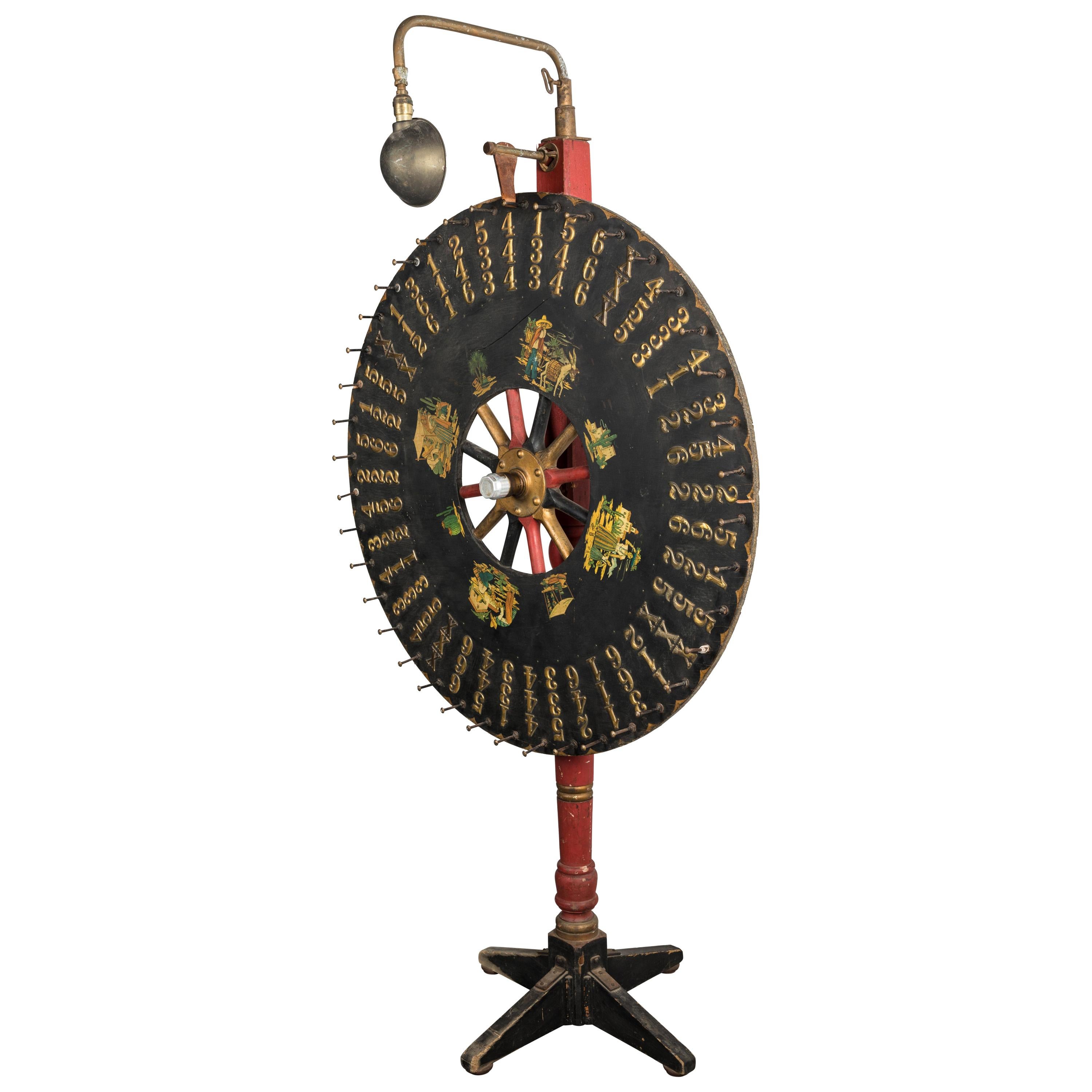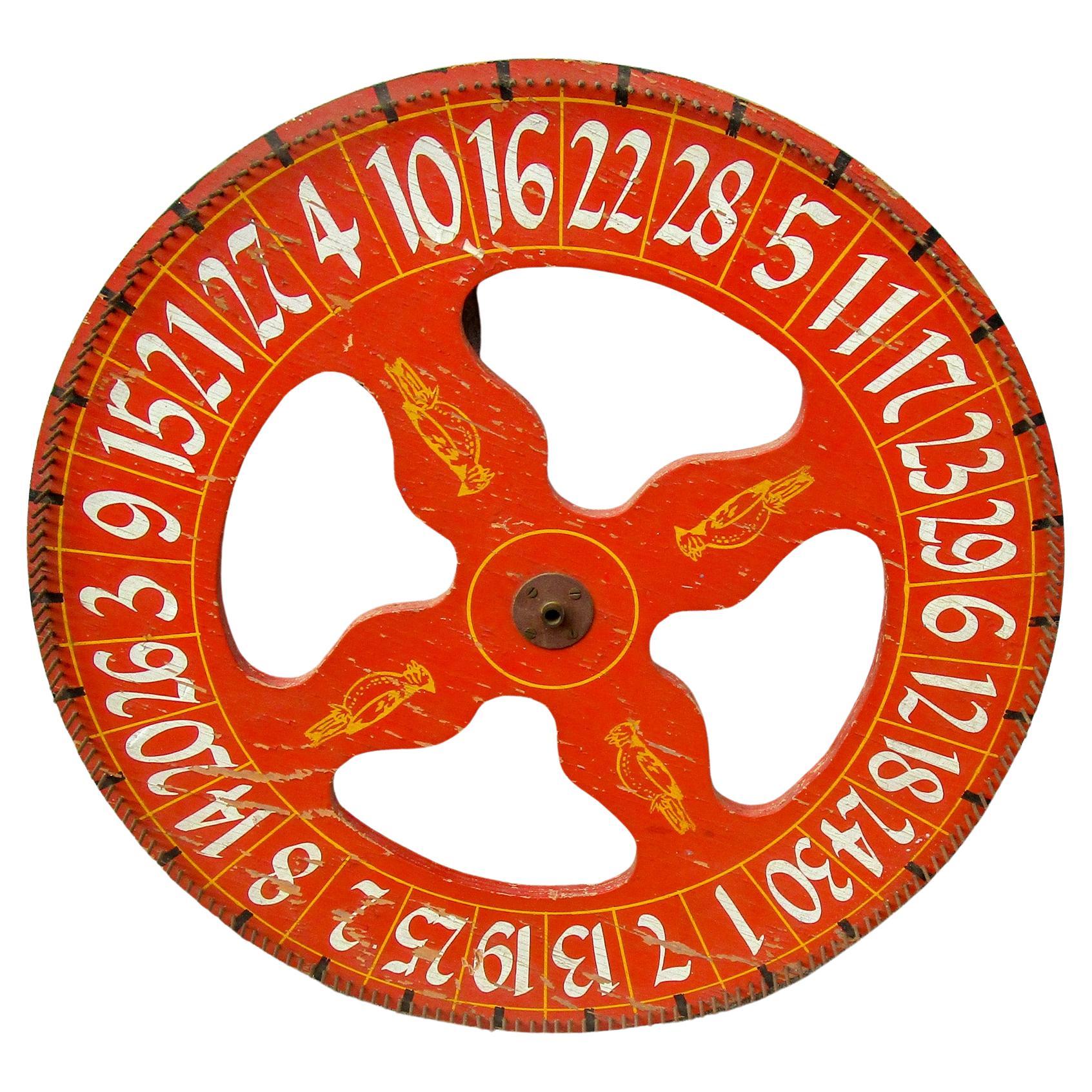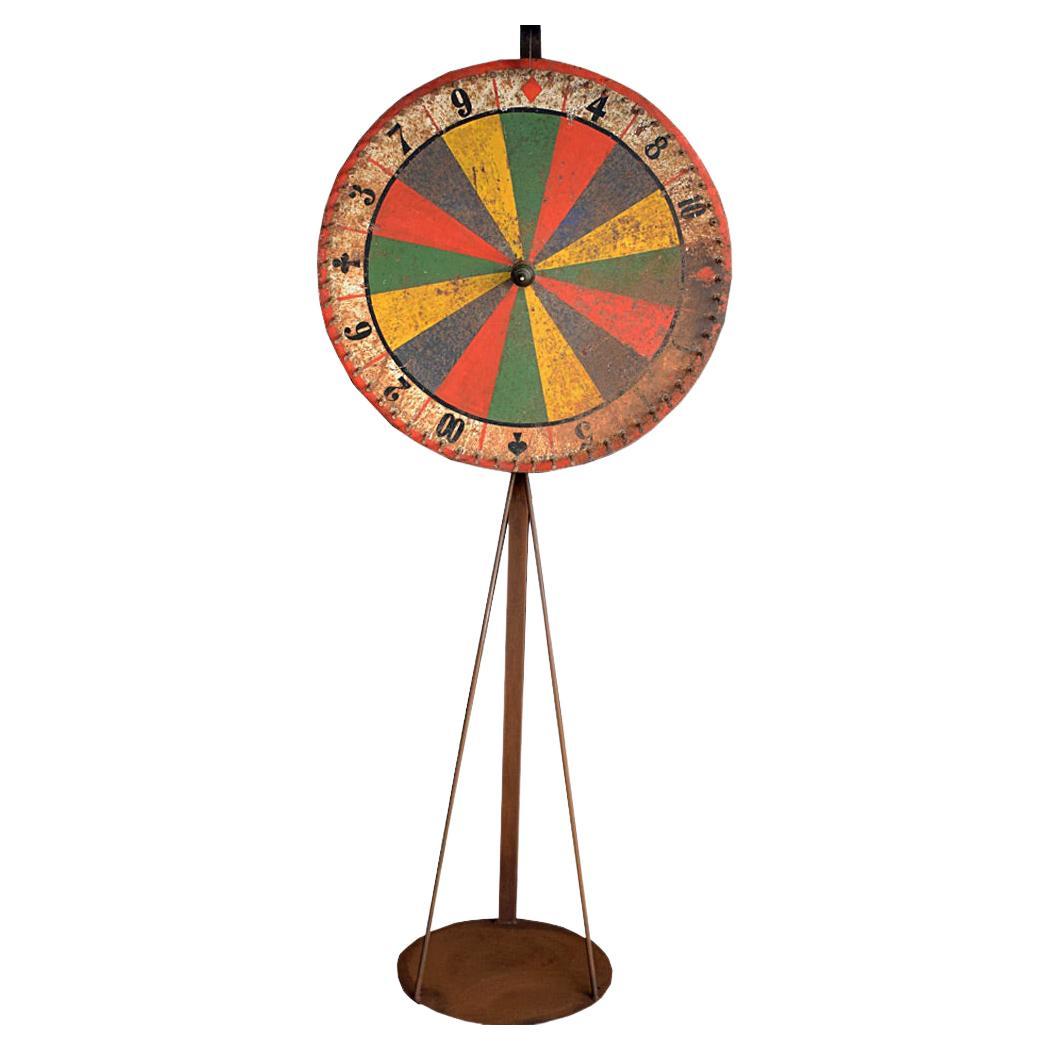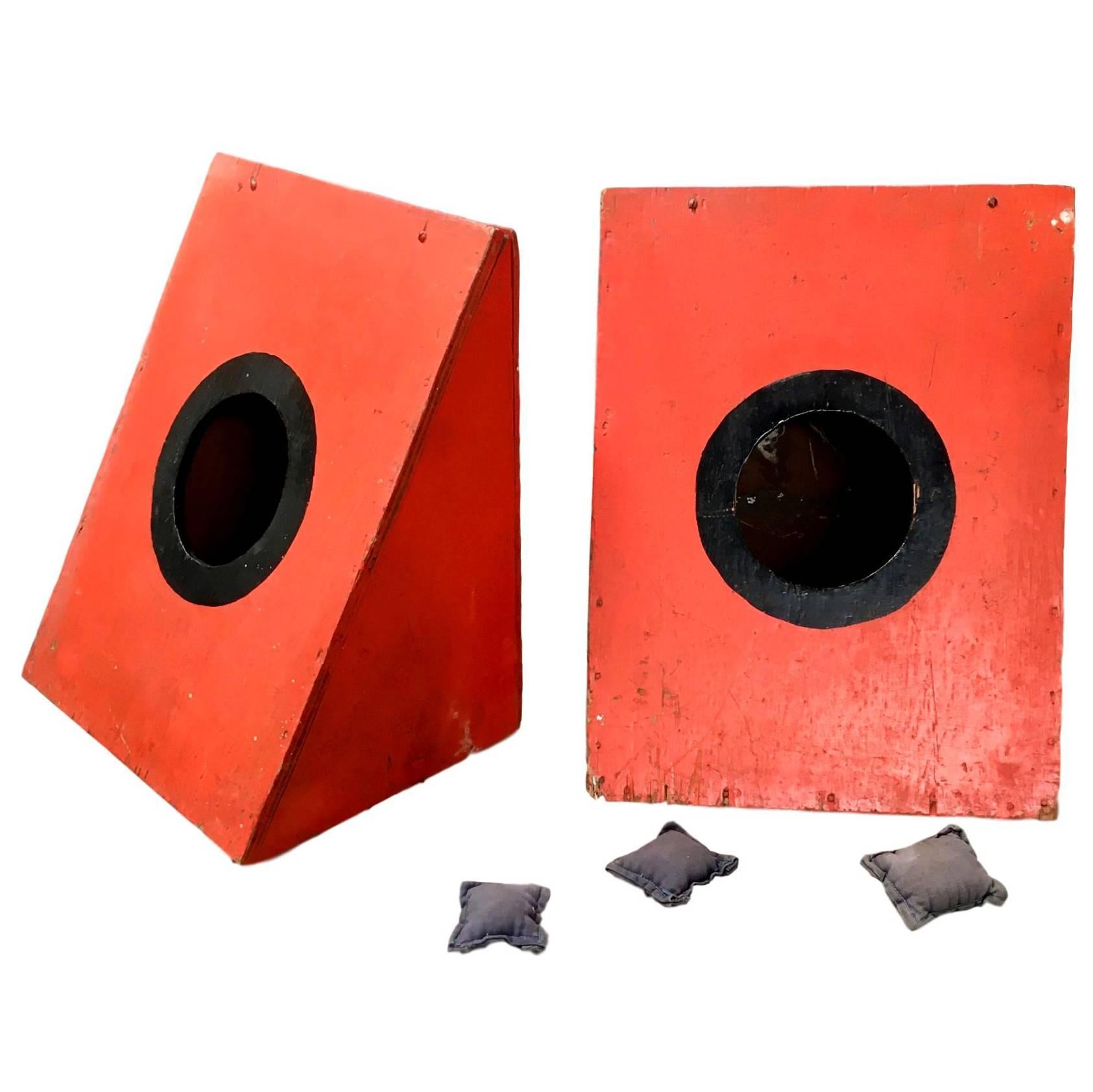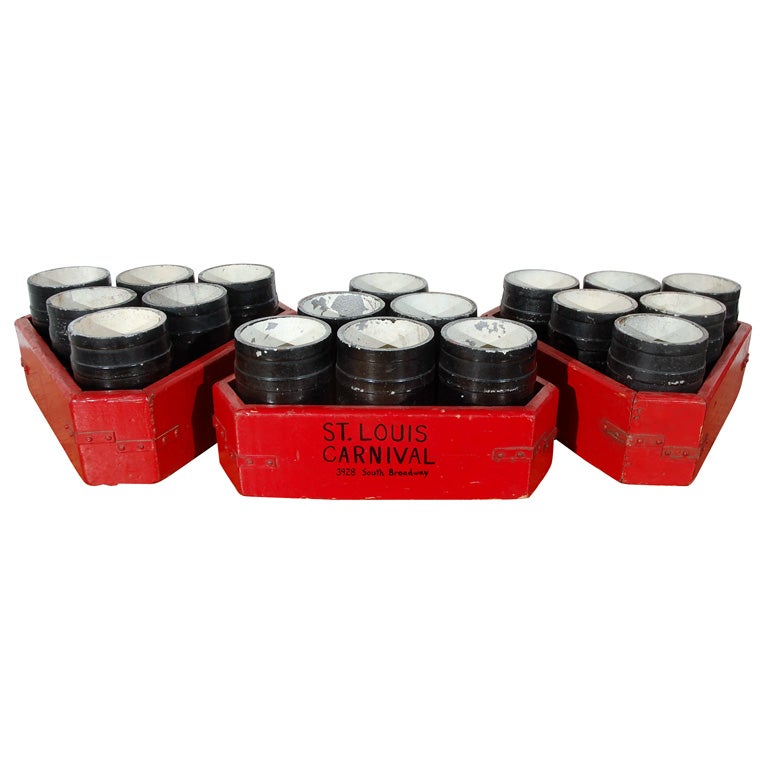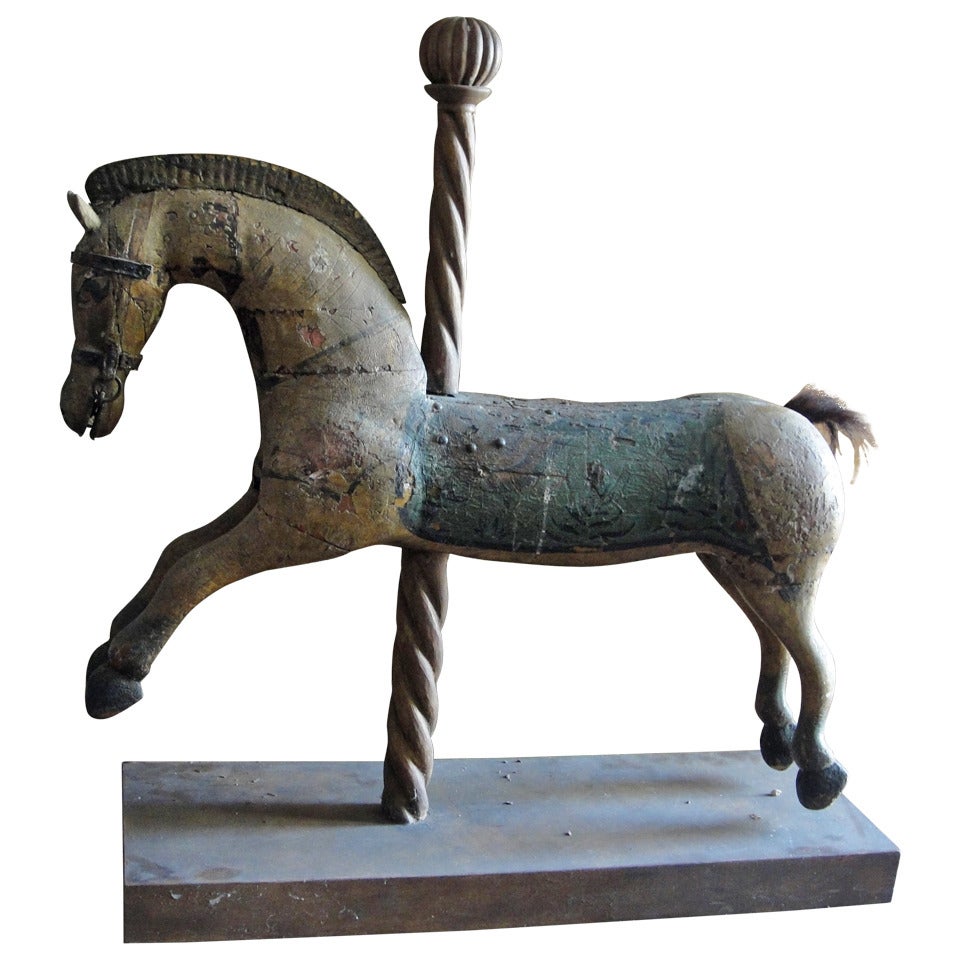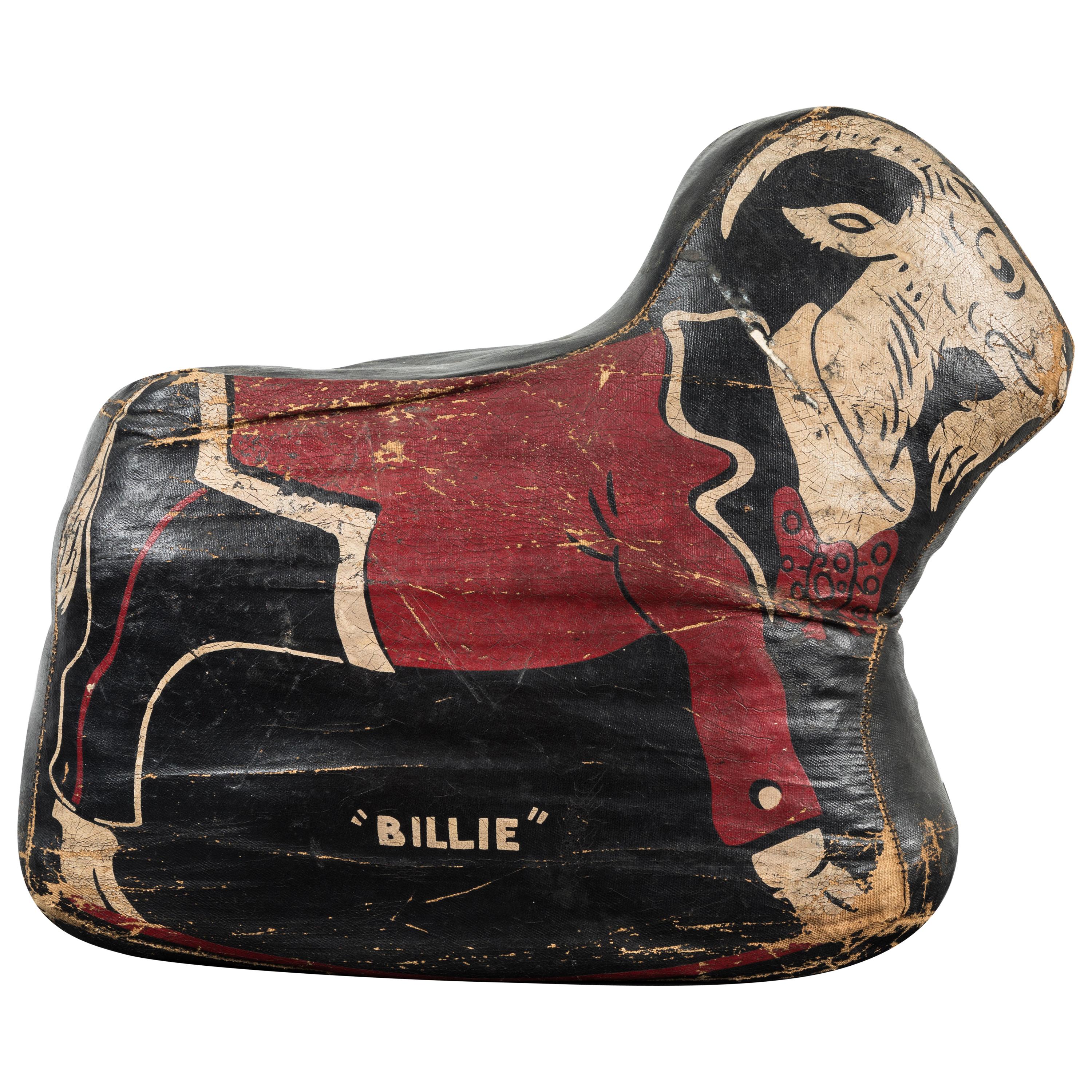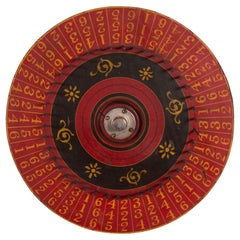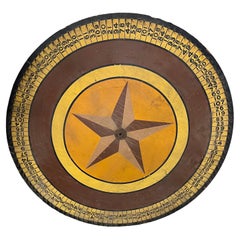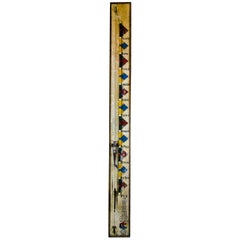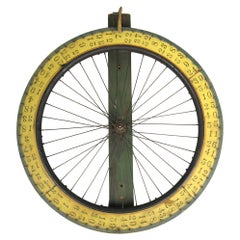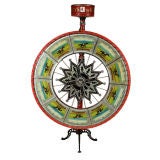
Race Horse Game Wheel, Ca 1930-50, Made By H. C. Evans, Chicago:
View Similar Items
Want more images or videos?
Request additional images or videos from the seller
1 of 7
Race Horse Game Wheel, Ca 1930-50, Made By H. C. Evans, Chicago:
About the Item
Elaborately embellished race horse gaming wheel, made by Evans & Company in Chicago. Each of the wheel's 10 panels are brightly colored lithographs behind glass, framed by lengths of decorative nickel-plated trim. The four crown-shaped center panels are foil-decorated mirror, framed with the same trim and finished with whimsical stars. Numbers would have once ran the outer edge of the wheel and were the real source of the game it was used for, which functioned quite like a ball-in-cage lottery with payouts that alternated based on the changing number in the cylindrical tower.
DYNAMIC RACE HORSE GAME WHEEL,
MADE BY H.C. EVANS, CHICAGO, CA 1950:
Elaborately embellished race horse gaming wheel, made by Evans & Company in Chicago. Each of the wheel's 10 panels are brightly colored lithographs behind glass, framed by lengths of decorative nickel-plated trim. The four crown-shaped center panels are foil-decorated mirror, framed with the same trim and finished with whimsical stars. Numbers once ran the outer edge of the wheel and were the real source of the game it was used for, which functioned quite like a ball-in-cage lottery with payouts that alternated based on the changing number in the cylindrical tower.
The polychrome painted wooden post that supports the wheel has a cast-iron, tripod base. It collapses for easy transport. The pins are nickel-plated.
Condition: Expected wear around the outer edges.
- Dimensions:Height: 87.5 in (222.25 cm)Diameter: 61 in (154.94 cm)
- Materials and Techniques:
- Place of Origin:
- Period:
- Date of Manufacture:1930-1950
- Condition:See item description.
- Seller Location:York County, PA
- Reference Number:Seller: gbd-0381stDibs: U080823849780
About the Seller
5.0
Recognized Seller
These prestigious sellers are industry leaders and represent the highest echelon for item quality and design.
Established in 1991
1stDibs seller since 2008
61 sales on 1stDibs
Typical response time: 10 hours
More From This SellerView All
- Colorful Painted Sheet Metal Game Wheel ca 1890-1910Located in York County, PACOLORFUL PAINTED SHEET METAL GAME WHEEL ON A SHAPED WOODEN FRAME WITH A NICKLE-PLATED SPINNER, circa 1890-1910 Red, black, white, and green game whee...Category
Antique Late 19th Century North American Game Boards
MaterialsWood
- Paint-Decorated Game Wheel in Scarlet Red, Chrome Yellow and Black, Ca 1880Located in York County, PAAmerican game wheel, made of wood, two-sided, with a fancy chrome spinner and long, metal pins. The polychrome-paint is simply a 10-out-of-10 in terms of color, graphics, and surface...Category
Antique 1880s American Game Boards
MaterialsWood
- "Visit to Camp" Rare Card Game by McLaughlin Brother of New York, Ca 1871Located in York County, PA“Visit To Camp,” an extraordinarily rare card game by mclaughlin brothers of new york, circa 1871. This extremely rare card game, designed with Civil War context, was made by McLoughlin Brothers in New York City. The set includes 12 (complete) chromolithographed, character playing cards, and 68 (out of 72) object cards, with various accoutrements. All of the above are housed in a wooden storage box with a slide lid and a chromolithographed, paper label. Played in an ad-lib, story-telling format, the characters include the Colonel, the Captain, the Zouave soldier with red pantaloons, the Rifleman, the Artilleryman, the Riding Master, the Musician, the Ferrier, the Surgeon, the Sapper (engineer), the Sutler (cook), and the Vi Vandeer (a woman who takes care of the troops). Each character was originally linked to 6 objects, which were to be produced by players on demand during a spoken reading of the game’s convoluted story-line. There are actually 69 cards included here, one of which is an object card for “the Chinaman.” Since the card matches the style exactly in printing, shape, and scale, and since there was no Chinaman in this game, I presume that the card must have once accompanied another McLaughlin ad-lib deck. The instructions (reproduced, in scale) list 13 possible players, with the 13th acting as narrator. I could locate only 3 other copies of this extremely rare game, all of which included 12 cards. McLoughlin Brothers is said to have pioneered the systematic use of color printing technologies in children’s books. The publishing firm opened in 1820 and was active until 1920, when it was sold to Milton Bradley. During the early years, the product line included toys in addition to books, among which were games, blocks, and paper dolls. Artwork from famous illustrators such as Thomas Nast, William Momberger, Ida Waugh” (Laura Wasowicz), Justin Howard, and Palmer Cox...Category
Antique 1870s American Political and Patriotic Memorabilia
MaterialsPaper
- Civil War Apron, Made In Cambridge, OH by Laura, Hynes, ca 1861Located in York County, PACIVIL WAR PERIOD APRON, MADE IN CAMBRIDGE, OHIO IN 1861 BY 12-YEAR-OLD LAURA HAYNES, WORN BY HER AT BENEFITS FOR THE U.S. SANITARY COMMISSION, PREDECESSOR OF THE RED CROSS, THAT STAFFED, FUNDED, AND MODERNIZED CIVIL WAR HOSPITALS Laura Haynes was born on the 17th of June, 1847 to Vincent and Sarah (Dillon) Haynes of Westland, Ohio (southeast of Columbus and due south of Zanesville). Vincent was listed as a physician in the 1850 U.S. Census, then as a lawyer in 1860, apparently having pursued both fields. It stands to reason that that during the Civil War (1861-1865), the Haynes family, being of means and with Vincent involved in the medical profession, might become involved in philanthropy to benefit Civil War hospitals. Made of plain weave cotton, this patriotic apron features 18 white, appliquéd, hand-sewn stars on a blue ground, cinched at the waist, with a blue belt incorporated below, followed by 13 vertical stripes, alternating red and white, likewise cinched, so that top and bottom have opposing triangular profiles. Aprons of this period did not generally have a loop or tie that went about the neck, to keep the breast portion up, but were rather pinned in place. All of the construction was accomplished by hand-stitching. One can see in the more crude stitching of the stars, how much more difficult it was to perform appliqué work than it was to hem fabric, especially for a 12-year-old girl. While the count of 18 stars may have had no purpose other than to fill the available space, to create a patriotic display, it may just as likely have been selected to reflect the number of states that were felt to be loyal to the Union at the time. Until July 4th, 1861, there were officially 33 stars on the American national flag. This, less the entire complement of 15 Slave States, would arrive at a count of 18. President Abraham Lincoln urged the nation not to do this, desiring not to give credence to secession, with his goal of keeping the Union together. But there were no flag police and people did as they wished, creating versions of the Stars & Stripes in both the North and the South that removed those the respective maker(s) deemed loyal to the opposition. Although rare, a number of American flags of the Civil War era are known that display 18 stars, likely to reflect the removal of 15 Southern States. In the upper center of the striped portion of the apron is a fraternal ribbon, made of blue satin silk, with a white metal brooch at the top and a gold button with an eagle below. This is decorated with a printed 13 star flag ribbon (applied), and with gilded text that reads: “The Women and Girl Workers of the Civil War; ’61-’65.” Next to this is the membership badge of the Women’s Relief Corp, which served as the women’s auxiliary of the Grand Army of the Republic, the primary organization for Civil War veterans. Below these, a hand-lettered exhibition tag was adhered, that reads as follows: “Made in 1861 at Cambridge Ohio by Laura Haynes; Age 12 Years; and Worn at Benefits for the Sanitary Commission [The Red Cross of 1861-5],” Followed by “Laura H. Green; Hotel St Mark; Oakland Calf.” Along the bottom of the tag is a brief title: “Flag-Apron of 1861-5,” with a circled item number “27.” The Sanitary Commission was founded in the Spring of 1861 by private citizens in New York City, who were appalled by the Army’s lack of medical supplies and sanitary conditions in the care of Civil War soldiers. Officially sanctioned by the War Department on June 9th of that year, and approved by Abraham Lincoln on June 13th, the chief planner and organizer was Boston-born writer and Harvard-educated clergyman, Henry Whitney Bellows of New York (b. 1814, d. 1882). Bellows modeled the organization after the work of Florence Nightingale in the British Sanitary Commission of the 1850’s, and brought with him a force of volunteers belonging to an organization he led called the Woman’s Central Association of Relief of New York. In 1863, Bellows would become one of the four founders of the Union League Club of New York, with fellow Sanitary Commission leaders Frederick Law Olmsted (the designer of Central Park, considered to be the father of modern landscape architecture,) plus George Templeton Strong (American composer, painter, lawyer, and prolific diarist), and Oliver Wolcott Gibbs (Harvard professor, chemist, and physician). The goal of the Union League Club was to join like-minded and influential, moneyed men with the cause of both the Commission and the Union in general. In 1881, Sanitary Commission nurse Clara Barton would carry the torch forward, expanding upon the concept to form the Red Cross. Sanitary Fairs—large, fundraising events held to benefit the Commission—were held in New York, Philadelphia, Baltimore, Chicago, St. Louis, and elsewhere. The Northern Ohio Sanitary Fair was almost certainly attended by Laura Haynes, 16 years old by that time, who is likely to have worn the apron there. Held in Cleveland from Feb. 22nd – Mar. 10th, 1864, the fair was opened by Major General James Garfield, future President of the United States, who, it is said, was extremely well received. About 3 years later, on June 11th, 1868, Laura married Robert M. Green of Cambridge, Ohio (northeast of Westland), who shared her June 17th birthday. Born 2 years prior to Laura, in 1846, Robert enlisted as a Corporal with “A” company of the 85th Ohio Infantry, a 3-month unit, on May 27th, 1862. Mustering in on June 10th, I Columbus, at Camp Chase, the 85th was assigned to guard Confederate prisoners at the garrison. He mustered out on the 23rd of September. By 1880, Robert & Laura Green had relocated to Oroville, California (Butte County...Category
Antique 1860s American Political and Patriotic Memorabilia
MaterialsCotton
Price Upon Request - Colorado State Flag, Made of Silk, Ca 1911-1920Located in York County, PACOLORADO STATE FLAG OF EXCEPTIONAL QUALITY, MADE OF SILK, CIRCA 1911-1920’s, EXTRAORDINARILY RARE IN THIS PERIOD AND THE EARLIEST EXAMPLE THAT I HAVE EVER ENCOUNTERED Early state flags are few and far between. While I am asked for them constantly, most states did not actually have official flags until the 20th century. On May 6th, 1911, Colorado became among the last to adopt a design. The project of doing so was spearheaded by the Denver Chapter of the Daughters of the American Revolution. The bill was introduced by Senator W.H. Sharply and adopted by the Eighteenth General Assembly. The artwork was the product of A.C. [Andrew Carlisle] Carson, President of the Ohio Society of Colorado. The meanings behind the elements in the design are as follows: The large letter "C" stands for Colorado and simultaneously for the Centennial State (Colorado entered the Union in 1876, the year in which our nation celebrated its 100th anniversary of independence), as well as the Columbine State (reflecting the state flower). The red color is included due to the fact that the word Colorado translates to scarlet or red in Spanish. The circle represents the sun, while the gold color symbolizes all-the-year sunshine, Colorado’s status as the greatest gold state, and one Columbine color. It was also included so that the Colorado state flag would have one more color than the U.S. flag. The color white reflects Colorado’s status as the greatest silver state, its eternal mountain snow, and one Columbine color. Lastly, the shade of Yale blue symbolizes all-the-year blue sky and one Columbine Color. Members of the D.A.R. were proud to note that this was also their color. Made sometime between the initial year of the adoption of this design and the 1920’s, this particular flag is the earliest Colorado example that I have ever encountered. The blue and white bars, red “C,” and golden circle are a’’ made of silk taffeta. This was a costly fabric, reserved for the best material a flag-maker produced. The flag is constructed in the manner of a battle flag, to be carried on foot. Squarish in its overall profile, silk was the fabric of choice for flags employed in this function, due to the fact that it was light weight, and thus practical for hand-carrying, while simultaneously formal in appearance, appropriate for the sort of ceremonial use that military presentation often demands. The style of the hoist is also typical for field or parade use. Here the fabric was rolled over to form an open sleeve, through which a wooden staff could be inserted. The sleeve is lined on the interior with black cotton. Leather tabs, at the top and bottom, fit over metal posts on the staff, designed to accept them, to fix the flag in its proper position. The bars were pieced and joined with lineal machine stitching. The hoist and fly ends were finished and hemmed by the same method. The devices are double-appliquéd (applied to both sides) with a machine buttonhole / blanket stitch. Though machines that produced buttonholes were, remarkably, available alongside the earliest standard machines, in the 1850’s and 60’s, the use of this sort of stitch in a running format, for appliqué work, remained highly unusual, even as late as the first half of the twentieth century, probably because it used a ton of thread when compared to the zigzag or satin stitch. It could be expected to appear more often in the hands of a maker of very fine flags, that employed embroidery machines and commissioned custom, fancy work of all sorts. Though unsigned—in no way uncommon in early examples, which were seldom signed—that is precisely the sort of firm that produced the Colorado flag...Category
Early 20th Century American Political and Patriotic Memorabilia
MaterialsSilk
Price Upon Request - Indiana State Flag, with Gold Fringe ca 1930-1955Located in York County, PAIndiana State Flag With Square-like Proportions, An Offset Device, And Gold Fringe, Circa 1930-1955: Despite the fact that most of the United States joined the Union during the 18...Category
20th Century American Political and Patriotic Memorabilia
MaterialsCotton
Price Upon Request
You May Also Like
- Large 19th Century Painted Game WheelLocated in Nantucket, MALarge 19th century wooden gaming wheel with hand-painted face including numbers and central nautical star design. In black, maroon, yellow, and orange paints, with metal dowels sepa...Category
Antique Late 19th Century North American Carnival Art
MaterialsMetal
- 1930 Wooden Carnival Game by French Game & Novelty, Milwaukee, WILocated in Surrey, BCUnusual Folk Art wooden carnival game in working condition and with original paint. Players bet on which city the spring-released airplane will land on. Made by French Game & Novelty...Category
Vintage 1930s American Folk Art Carnival Art
MaterialsWood
- Hand Painted Early Americana Folk Art Wall Mount Game WheelLocated in Wallkill, NYWhat a great addition this would make to your home Folk Art game wheel, measuring 31 in x 34.5 in height x 5 in deep.Category
Vintage 1920s American Folk Art Carnival Art
MaterialsWood
- Early Carnival Midway 7.5 Foot Tall Game Wheel Monterey with Gooseneck LightLocated in Santa Monica, CAFantastic giant carnival game wheel with applied scenic Monterey theme. All original surface paint. Chunky turned stand. Measures: 7 foot . Really unique gooseneck lamp for illuminat...Category
Vintage 1920s American Folk Art Carnival Art
MaterialsWood
- 19thc Wooden Folk Art Gaming Wheel with Original Red Paint & Cardinal DesignLocated in Savannah, GA19th Folk Art gaming wheel featuring four cardinals and hand painted numbers, it retains the original red and yellow paint. A charming piece of Americana that would make a colorful w...Category
Antique 1890s American Folk Art Carnival Art
MaterialsMetal
$596 Sale Price25% Off - Scratch Built Fairground WheelLocated in London, GBScratch built fairground wheel Mounted on a bespoke cast iron detachable support stand, this unique, folk art, scratch-built fairground roulette wheel is still in fully working order. We would say dated from the mid-20th Century the wheel is made from an old bicycle...Category
Vintage 1950s British Folk Art Carnival Art
MaterialsMetal
Recently Viewed
View AllMore Ways To Browse
Vintage Wooden Wheel
Carnival Glass Vintage Carnival Glass
Vintage Carnival Glass
Decorative Mirror Iron Frames
Carnival Wheel
Vintage Cast Iron Horse
Polychrome Cast Iron
Vintage Cast Iron Mirror
Vintage Cast Iron Panel
Vintage Carnival Wheel
Painted Folk Art Metal Horse
Carnival Gaming Wheel
Carnival Game Wheel
Vintage Cast Metal Horse
Wooden Folk Art Plates
Vintage Carnival Horse
Lottery Vintage
Vintage Wheel Trims

